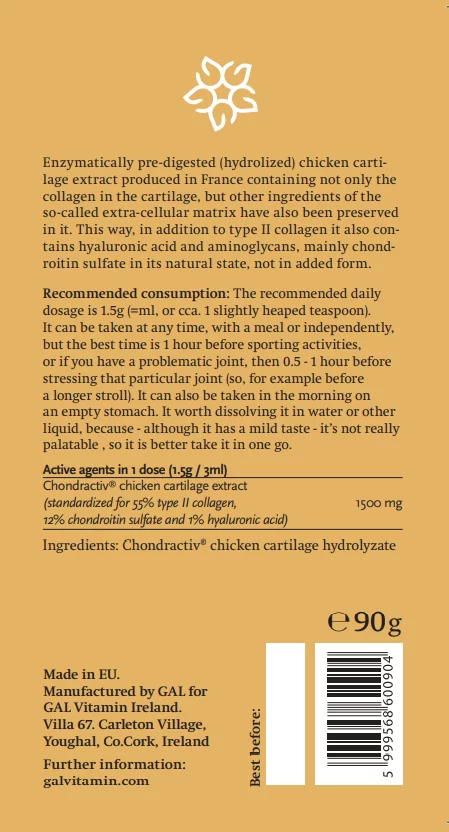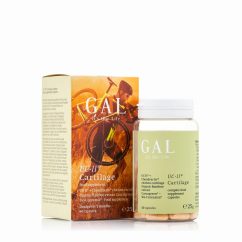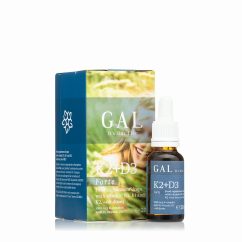
Classification of collagen products is simpler, there are only 3 main types, as introduced in the following paragraphs.
- Products containing type I collagen (gelatin and collagen peptides)
It is often called Type I+III, as with Type I there is always some Type III, as well. It is produced from skin and/or bone. This is a universal collagen type, which has a beneficial effect not only on joints but also on skin, hair, nails, intestinal flora, intestinal mucosa, bones and muscles. Its effect on the joints is mainly manifested in the effect on the viscosity and volume of joint fluids, and - besides the fact that joints, i.e. cartilage, are made of type II collagen, also type I contains the building blocks of type II (corresponding ratios of amino acids and special peptides), so indirectly it is also capable of providing the building elements for the type II collagen proteins of cartilages. In addition, due to its peculiar amino acid profile, it is worth looking at type I collagen as a source of calories and proteins. In fact, it would be ideal if one-third of our protein intake would come from collagen (broth, skin, nail stew, tripe, jelly, etc.)
Type I collagen products are gelatin and hydrolyzed collagen or collagen peptides. Gelatin is barely pre-digested, it is a giant protein extremely difficult to dingiest (50-100 thousand Daltons = Da), whereas collagen peptides are more pre-digested (hydrolyzed), in optimal cases below 8 thousand Da (below 8000 Da in gets to the bloodstream also through the so-called peptide channels, as well, which means that it does not need to be digested. GAL collagen peptides are all below 5 thousand Da). There are base ingredients of pork, bovine and fish origin on the market, and the only difference between these products is the Neu5Gc content, their effect is virtually identical. Their typical effective daily dosage varies between 5-15 g, and although the positive impact of fish collagen on the skin at a daily dosage of already 2.5 g has been confirmed by an analysis, the typical daily dosage is around 10 g.
- Type II collagen non-denatured and non-denaturing during digestion
They are practically raw cartilage brought to a saline form to resist digestion and to be absorbed in their raw form by the lymphoid organs in our small intestine similar to our tonsils, and this way - getting to the lymphoid circulation - to modulate our immune system by reducing/preventing immune attacks against our own joints (antibody generation), and the consequential inflammation. As a result of joint friction, cartilage proteins may denature, which may be recognized by the organism as foreign proteins and launch a counter-reaction against them. This collagen type helps hold back this reaction. This is the so-called oral tolerance. They include UC-II which was the first such base material, and it has been the subject of most clinical tests, As far as we know, besides UC-II there is only one similar base material on the market. Both are made from chicken cartilage.
They have a specific effect on the joints.
The typical daily dosage of this collagen type is 0.04 g, i.e. 40 mg (for the saline form, and even less for the type II collagen itself).
- Partially hydrolyzed cartilage collagen matrix or cartilage extra-cellular matrix
Base materials of this category practically contain the entire extra-cellular matrix of cartilages, i.e. not only type II collagen protein, but also other amino glycans (mainly chondroitin-sulfate) and hyaluronic acid. So, here the type II collagens are already present partly in hydrolyzed (partly pre-digested) form, they do not stay in raw form, and do not form the oral tolerance identified for the previous type.
however, they also provide building material to the cartilages also directly, and not only indirectly, as type I. Additionally, they also contain other components of the joints and joint fluid mentioned earlier, not in added form, but as part of a natural matrix, and so a lot less of them is sufficient. It can practically be compared to a cartilage soup prepared thoroughly at low heat. If you will, it is a standardized, controlled and instant concentrate of it.
Base materials available on the market are gained from pork, bovine, fish or chicken collagens, and there is also a version extracted from the membrane of the inner surface of the eggshell. Ratios of type II collagens, amino glycans and hyaluronic acid are different in them, but otherwise, they are virtually the same.
These, too, mainly impact the joints (increasing joint fluids + direct building material), however - due to their hyaluronic acid content - they have some beneficial effects on the skin, as well, although not so remarkable, as type I collagen. The typical daily dosage is between 0.5 g, i.e. 500-2000 mg.
We’ve already had two of the 3 types of collagen products (3 kinds of the first: GAL Fish collagen peptides/ GAL collagen peptides, and GAL UC-II® Cartilage Complex from the second type). Now, with the release of the new GAL Chicken cartilage complex (Chondractiv® extra-cellular matrix extract), all types are finally available.
The French base ingredient registered under the name Chondractiv® is produced exclusively from chicken cartilage. Taking into account the respective prices and collagen/aminoglycan/hyaluronic acid ratios of all base materials of this type, we found that they are not very different in terms of their effect, all the more so in terms of economy. In the end, Chondractiv® won... Furthermore, as it is made solely from chicken cartilage, it is also free of Neu5Gc (to whom it matters).
Recommended daily dosage is 1.5 g.
Which one and when?
If our goal is to improve our skin, hair, nails, and intestinal system or to slow down ageing (cf.: Bence Szabó Gál - On collagens), then we should undoubtedly choose the type I collagen.
Even if the explicit reason for trying them is our joints, we still recommend collagen peptides, potentially supplemented with GAL Bio-Curcumin Forte. For also collagen peptides, and - via completely different mechanisms - Curcuma is also good for the joints, but they also have a great many positive effects on the organism, so if one or both of them were sufficient for the desired improvement (in about 2 to 3 months), then we have brought out the best of it. If not, then it is worth trying our new Chondractiv® product or UC-II. And of course, also in case, if collagen peptides and/or Curcuma helped, we expect further improvement.
It very much depends on the person, which product is the best, but perhaps it can be said in general that UC-II is more efficient in cases of autoimmune origin (Rheumatoid arthritis), whereas Chondractiv® is considered to be the better choice for joint wearing. It is recommended to try one or another product for 2 months, and if no improvement is observed during this period, then select another one.
The maximalist solution is of course to take all three types of collagen products (+ GAL Bio-Curcumin Forte), and later quit one of them for 1 or 2 months (starting with Chondractiv® and UC-II®, as they are only good for the joints). And if the problem would not return once they are not taken anymore, then stick with only the collagen peptides (and/or Curcuma).
Made in the EU
Warnings
KEEP OUT OF REACH OF CHILDREN. DO NOT EXCEED RECOMMENDED DOSE.
If you are undergoing treatment for a medical condition or if you are pregnant or lactating, please consult your medical practitioner before introducing supplementary foods to your normal routine. The dietary supplement should not be used as a substitute for a varied and balanced diet or a healthy lifestyle. Store tightly closed in a cool and dry place.

- Allergen-free
- Glutenfree
- Egg-free
- Soy allergen-free
- Dairy and lactose-free
- Free of sulfur dioxide
- Sugar-free
- GMO-free
- Vegetarian
- Vegan
- 100% recyclable packaging
Green: The product has the described property
Red: The product does not have the described property




